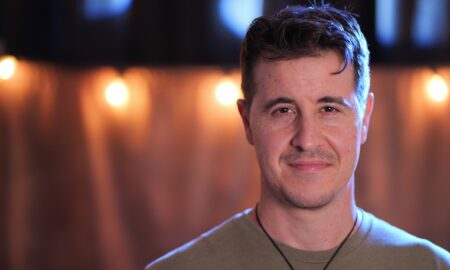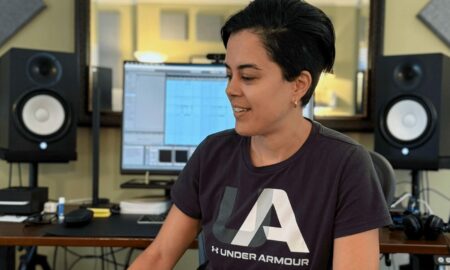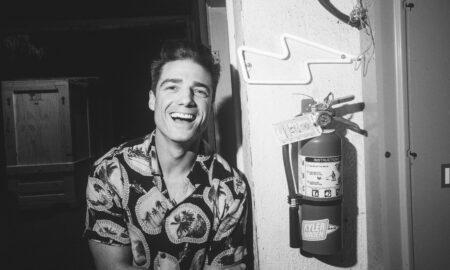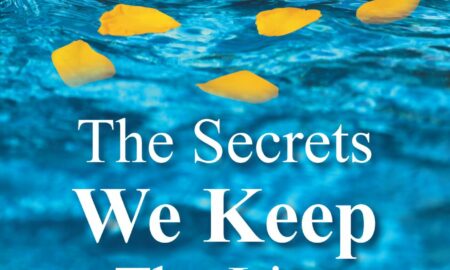

Image credit: Travis Shinn
Today we’d like to introduce you to Jeremy Danger.
Jeremy, please share your story with us. How did you get to where you are today?
Women in rubber is where it really started for me. I had been shooting stills since middle-school, but it wasn’t until I moved to San Francisco for college in ’99 when I began using my camera with artistic intention. I had enrolled in The Academy of Art, focusing on directing and cinematography. The art scene in SF blended with the fetish scene because the people who lived in San Francisco at the time weren’t afraid to get turned on. As far as I could see, everyone was actively looking for a good time and they were hungry to embrace it wherever it might be found. I found it behind a camera with women dressed in latex. The initial thrill of shooting women in latex is obvious, but there are deeper psychological layers to explore after you scratch the surface. The unabashed endeavor to discover and experience beauty in new ways cultivates a profound feeling of freedom. It was there, then, and with that feeling that I began to develop as an artist.
Still-photography is seductive because it’s relatively quick and easy to produce and deliver compared to motion, especially since the motion of the day was still shot on film. Although I was studying motion in school, it was my still-photography that gave me my start in a world where pictures could pay the bills. With some gained wisdom from a surrealist photographer, David Gaz, and from the Godfather of Fetish, Eric Kroll; along with some opportunities from gallery-runner, Justin Giarla, my gateway to the commercial world was through the Fine Art scene.
What’s more fun than making pictures of exactly what you want? Nothing. Nothing is more fun, but ‘fun’ is just scratching the surface of what feelings picture-making can conjure. I wanted to do more and do “it” bigger and better. I wanted to satisfy deeper aspirations. Motion was still taking up a huge space in my heart. In ’05, it became painfully obvious to me that I had to move to LA if I was going to do anything that I felt was worthwhile. I felt that sinking feeling as I drove out of the city, but after just a few days in LA, I thought to myself, “I should have moved here years ago.”
If you want to get shit done, come to LA. If you want to sharpen your eye and hone your craft, throw yourself on the bonfire that is LA. Embrace the transformation that comes with living in LA. I travel a lot and in my experience, nowhere but LA is it more painless to produce a project. The equipment, locations, and specialist working in the picture business are of the finest caliber. Fortunately, I was embraced by OTMFC, a local grip house and de facto hub for a crew of photo-assistants that are the best of the best in LA. I began to develop a more critical eye and improve my business acumen under the tutelage of excellent photographers Sean Murphy, Sheryl Nields, Melanie Acevedo, and a few others; as well as a handful of masterful first-assistants like Keith Leman, who prefer to remain behind Oz’s curtain. Like a baby bird in a nest, eventually, it felt like the right time to take the leap and fly on my own.
For years now I’ve been working with motion and stills regularly. The intimacy of stills is something I cherish. I don’t mean the relationship between talent and I as much as the connection I have with the process. The light, the color, the form; these are the elements that excite me. When I’m laying in bed waiting for my thoughts to calm down and surrender to sleep, imagining colors on forms with actions is what’s keeping me awake. Yes, of course, the subject plays a part in where and how this process goes, but the look of everything is what I’m in love with. If I believed in luck, I might chalk up my experiences with my subjects to being lucky since I’ve yet to have had an unpleasant experience directly with any of my subjects. I shoot portraits of celebrities, musicians, and as a labor of love, I have an ongoing portrait series featuring the greatest minds of our time. I’m proud that my subjects range from icons of rock like Slash to the greatest intellectual of our time, Noam Chomsky.
Even when motion is taking up a great deal of time, I still like to sneak in the time to shoot stills. Still-photography satisfies an altogether different monster than motion like I said, it’s intimate. Motion has many more moving parts and many more cooks in the kitchen. I love motion because of the complexity of the process to achieve the vision and tell the story. Music videos have been keeping me busy this year too. With my good friend, Travis Shinn, I’ve had a great time making videos for Marylin Mason, Motionless in White, Vimic, Killswitch Engage, and a handful of others. On the commercial side, I was excited to do my first gig with Netflix, who I think we can all agree is blazing the trail for the future of viewing content. Although I love music videos because they afford the opportunity to experiment and do rad things like lighting a man’s head on fire, narrative motion is where I’d like to start focusing my efforts.
Has it been a smooth road?
I’m reminded of the analogy that show-business is like a duck: above the water it’s gliding, it’s smooth and graceful – below the surface, it’s trashing like hell. Every year things have gotten better and better in regards to the quality of my work and to my list of clients, but that hasn’t happened effortlessly. It takes a lot of thought and hard work to keep things running smoothly. There’s a naive, romantic, notion that a photographer’s job is as simple as pressing the shutter-release, getting the shot, and then “voila!” the work is done. After that, it’s time to travel, play, and post it all on Instagram. In reality, there’s an endless list of tasks that one could consume themselves with in an effort to keep their business growing, especially when trying to retain one’s artistic integrity. The days that I’m not shooting on set are mainly spent in my office, in front of my computer doing the myriad things that one has to do to keep steaming full-speed ahead: editing, retouching, data asset management, book-keeping, updating this and that, shit on the internet, etc., etc..The shooting, traveling and playing are really just the first few layers of the onion that is this business. I saw a t-shirt that read, “I’d rather work a hundred hours a week for myself than 40 for someone else.” That’s the truth.
The main challenges I face aren’t uncommon. They are time and money. I love my work, so I’m never bored and I’ve always got something to work on. Often, it can feel as if I have too much on my plate, but nothing has come crashing down yet, so I must be managing my workload well. As busy as I get, there are plenty of other endeavors that I’m super-eager to start. An idea will take hold and root itself into my mind. These unborn projects are the thoughts that keep me from falling asleep because I can’t help but continually go over details. Those ideas are the thoughts that I’m mulling over throughout the day, while I listen to music, while I eat, while I ride in an elevator… I recognize “old business before new business,” that one must finish a project before moving on, otherwise it’ll always be there, nagging, “finish me, you fucker!” I hear another voice too, “Start me, you fucker!” It doesn’t stop. Time is a luxury and finding some “free time” to invest in a new project is a feat on its own. Between business and life, a more ideal workflow would allow more time between projects, allowing those projects the breathing room to form more fully…which brings me to money.
Time is money. Money is a cunt. Money is a necessary evil. Money is peace of mind. Early on in my career, I preferred natural light. Now, I like to command the look of what I’m shooting because no detail is small – I like to light. I like to bring a production to a shoot. Production-costs add up and even the humblest of endeavors can poke a bunch of holes in my wallet. Nothing is free and big ideas require big funding. On the commercial side, it’s a rare unicorn of a client to catch who says, “yeah, man, spend whatever you want!” It’s just not the world we live in. With the technological marriage of motion and stills, many clients, and potential clients, desire more for less. Most have seen the Venn diagram with cheap, fast, good – pick two, but few think that applies to them. Not all clients, I must say. Some clients, agencies and editorial teams, are right there with you, arm-in-arm, fighting the good fight with a clear understanding that money has to go to the right people and places for you all to make the best damn project possible. These dream clients are often the ones producing and distributing the most impressive and respected work that’s out there.You know the work. Usually, the clients that are trying to stretch the dollar the most are the ones operating from a position of corporate fear or inexperience. A conversation that starts with a discussion about a lack of budget is indicative of a team that lacks organization and vision. As best as I can, I avoid these clients because the quality of the work often suffers, and that’s a recipe for a broken heart. The goal is to do good work. Then to do good work better. Everyone knows that time and money make that process more comfortable.
If I were more cynical, I might say that I sacrifice much to work. I’ve missed many holidays and anniversaries with my wife. We postpone vacations to accommodate work. At times I must isolate myself to finish work. But, as the great philosopher, Hyman Roth said, “This is the business we’ve chosen.” Life is pointless except for the meaning we give it. For me, it’s to do work. Nothing is done in vain when it’s done working towards a goal, and I recognize that with a smile on my face. There’s no place I’m happier and more alive than with a camera.
What is the most difficult part of what you do?
Challenges are inextricably linked to goals. Big goals, big challenges; small goals, small challenges. The most challenging part of my work is connecting with the right people for the right jobs. It sounds simple, but it’s like spinning plates while also arm-wrestling an octopus. When a job starts and the team comes together and the passion is so electric that everyone is buzzing – you know the job is going to be even better than initially thought. When the job ends, you’re proven right, and you’re all flying high – not much beats that. That’s the high that we’re all chasing. Those jobs are out there, right now, and there are a lot of them. Many things can be done to earn a dollar. The “right job,” feels more like love, than a trade for valuable time. Which brings me to a close second when considering challenges.
Time and money – what hasn’t been written on their special relationship. They, too, are so inextricably linked that I think I’m within reason to refer to them here as a singular, compound-challenge. Money creates the pressure of time as time is reduced to a measurement of cost. Dealing with budgets, it’s obvious how this beast feeds itself and why it’s appetite is always growing. Not much gets accomplished without money and nothing is done without time. More of both would be terrific.
How do you define success?
Success is an ongoing process of mastering one’s craft while earning respect and value. Material possessions are attractive and having the humdrum tasks of daily life sorted out would be a dream, but death is certain, so the main goal should be to enrich one’s name through self-improvement and work done well. “Onward and upward,” must be the battle cry. Complacency is the same as going stale and must fight. To constantly be learning and evolving is freedom. And as the saying goes, “the higher a monkey climbs, the more you see of its behind.”
In the sense of day-to-day, now, I imagine the feeling of being successful would come with larger budgets, larger audiences, and the freedom to take some breathing room between projects, both for the value of “extra” pre-production time, as well as for the space to cultivate new ideas.
What are your plans for the future?
2016 was a good year. I’m proud of the portraits that I’ve shot and I’ve pumped out a good handful of music videos. I’d like my directing work to continue its upswing, and I’d like to move towards narratives.
I’m excited that we’re living in a bonanza of content and at a time where distribution is being revolutionized to reach wider audiences more easily. I see a golden horizon with operations like Netflix and Amazon distributing content in a new way while avoiding the shackles-of-banality that has trapped traditional networks for so long. Exciting times for exciting content. I’ve got my eye on that platform.
Contact Info:
- Website: www.jeremydanger.com
- Phone: (415) 225 -9767
- Email: [email protected]
- Instagram: https://www.instagram.com/jeremydangerpictures/
- Facebook: https://www.facebook.com/jeremydangerpictures/
- Other: http://jeremydanger.com/blog








Image Credit:
Slash; Jinxx of The Black veil Brides; Cherushii; Bill Nye; Noam Chomsky; Cortez Bryant; Richard Dawkins; Genevieve Liberte; Hair and Makeup: Lultte Danger



















